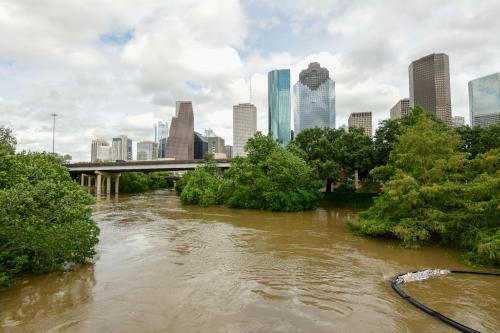In this Charts of the Week edition, a look at how some banks rely heavily on overdraft fees for profits, the demographic issues around a growing aging U.S. population with a stagnant younger population, and how a new climate planning unit in the White House can help improve federal climate action.
 Aaron Klein examines how for a number of small banks overdraft fees have become a significant source of their net income. “These banks are really check cashers with a charter,” he writes, asking “Why do bank regulators tolerate this?” Klein argues that regulators need to “crack down” on such institutions: “These regulators that allow banks to have a business model that depends on a single fee, charged only to consumers who run out of money, are not protecting the ‘safe, sound, and fair operation’ of the banking system.”
Aaron Klein examines how for a number of small banks overdraft fees have become a significant source of their net income. “These banks are really check cashers with a charter,” he writes, asking “Why do bank regulators tolerate this?” Klein argues that regulators need to “crack down” on such institutions: “These regulators that allow banks to have a business model that depends on a single fee, charged only to consumers who run out of money, are not protecting the ‘safe, sound, and fair operation’ of the banking system.”
 William Frey documents the aging U.S. population and the relatively stagnant growth of younger generations whose labor will increasingly support their elders in decades to come. Frey notes that the overall share of children (under 18) in the U.S. population has dropped from 35.7% in 1960 to 22.1% in 2020, and is projected to fall to 20.6% by 2040. Also, this younger generation is becoming more diverse racially and ethnically, and its modest growth is being fed by children of color who “stand on the wrong side of rising racial and ethnic inequalities.”
William Frey documents the aging U.S. population and the relatively stagnant growth of younger generations whose labor will increasingly support their elders in decades to come. Frey notes that the overall share of children (under 18) in the U.S. population has dropped from 35.7% in 1960 to 22.1% in 2020, and is projected to fall to 20.6% by 2040. Also, this younger generation is becoming more diverse racially and ethnically, and its modest growth is being fed by children of color who “stand on the wrong side of rising racial and ethnic inequalities.”
“In the decades to come,” Frey writes, “children will be a far rarer demographic commodity than they were in the nation’s past. This is why they need to be nurtured. Not only are they America’s future, but the youth will become an important asset to our future labor force, which will be tasked with supporting an increasingly large retiree population.”

In a new paper for the Blueprints for American Renewal and Prosperity series, experts explain how American transportation, water, and housing—what they call “land use systems”—contribute to the growing climate challenge, and argue that a new White House office can help “reduce the federal fiscal impacts of climate change by developing strategic intra-agency and cross-agency mitigation and adaptation projects and programs.” In their paper, they document the increasing federal expenditures on climate action in key areas, and outline how this new Climate Planning Unit can contribute to more effective federal climate action.




Commentary
Charts of the Week: Overdraft fees; stagnant US child population growth; federal climate planning
March 5, 2021